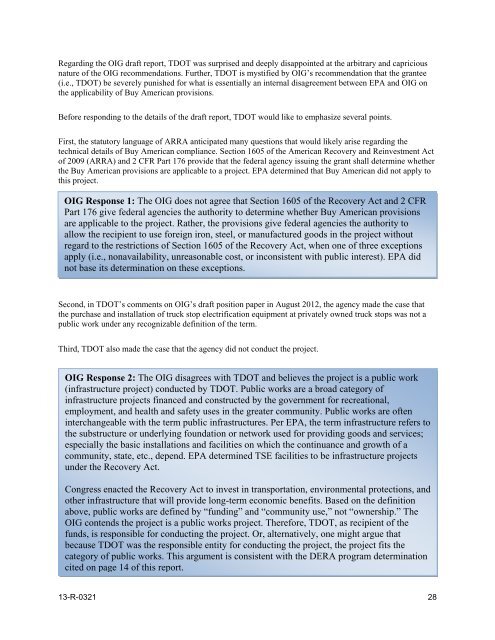Report PDF - US Environmental Protection Agency
Report PDF - US Environmental Protection Agency
Report PDF - US Environmental Protection Agency
You also want an ePaper? Increase the reach of your titles
YUMPU automatically turns print PDFs into web optimized ePapers that Google loves.
Regarding the OIG draft report, TDOT was surprised and deeply disappointed at the arbitrary and capricious<br />
nature of the OIG recommendations. Further, TDOT is mystified by OIG’s recommendation that the grantee<br />
(i.e., TDOT) be severely punished for what is essentially an internal disagreement between EPA and OIG on<br />
the applicability of Buy American provisions.<br />
Before responding to the details of the draft report, TDOT would like to emphasize several points.<br />
First, the statutory language of ARRA anticipated many questions that would likely arise regarding the<br />
technical details of Buy American compliance. Section 1605 of the American Recovery and Reinvestment Act<br />
of 2009 (ARRA) and 2 CFR Part 176 provide that the federal agency issuing the grant shall determine whether<br />
the Buy American provisions are applicable to a project. EPA determined that Buy American did not apply to<br />
this project.<br />
OIG Response 1: The OIG does not agree that Section 1605 of the Recovery Act and 2 CFR<br />
Part 176 give federal agencies the authority to determine whether Buy American provisions<br />
are applicable to the project. Rather, the provisions give federal agencies the authority to<br />
allow the recipient to use foreign iron, steel, or manufactured goods in the project without<br />
regard to the restrictions of Section 1605 of the Recovery Act, when one of three exceptions<br />
apply (i.e., nonavailability, unreasonable cost, or inconsistent with public interest). EPA did<br />
not base its determination on these exceptions.<br />
Second, in TDOT’s comments on OIG’s draft position paper in August 2012, the agency made the case that<br />
the purchase and installation of truck stop electrification equipment at privately owned truck stops was not a<br />
public work under any recognizable definition of the term.<br />
Third, TDOT also made the case that the agency did not conduct the project.<br />
OIG Response 2: The OIG disagrees with TDOT and believes the project is a public work<br />
(infrastructure project) conducted by TDOT. Public works are a broad category of<br />
infrastructure projects financed and constructed by the government for recreational,<br />
employment, and health and safety uses in the greater community. Public works are often<br />
interchangeable with the term public infrastructures. Per EPA, the term infrastructure refers to<br />
the substructure or underlying foundation or network used for providing goods and services;<br />
especially the basic installations and facilities on which the continuance and growth of a<br />
community, state, etc., depend. EPA determined TSE facilities to be infrastructure projects<br />
under the Recovery Act.<br />
Congress enacted the Recovery Act to invest in transportation, environmental protections, and<br />
other infrastructure that will provide long-term economic benefits. Based on the definition<br />
above, public works are defined by “funding” and “community use,” not “ownership.” The<br />
OIG contends the project is a public works project. Therefore, TDOT, as recipient of the<br />
funds, is responsible for conducting the project. Or, alternatively, one might argue that<br />
because TDOT was the responsible entity for conducting the project, the project fits the<br />
category of public works. This argument is consistent with the DERA program determination<br />
cited on page 14 of this report.<br />
13-R-0321 28
















